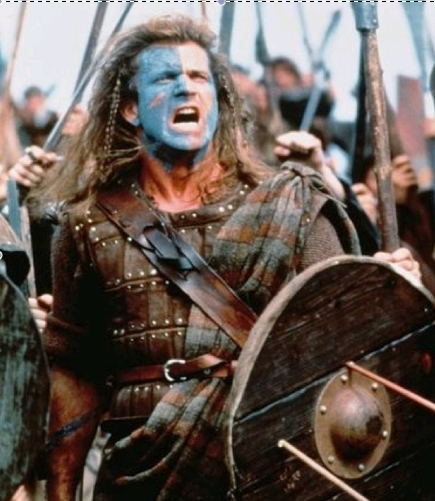William Wallace - The
Wallace - is world famous; a national hero who fought and died to free Scotland
from English rule.
William is thought to
have been the younger son of a Scots landowner, Alan Wallace. In the
Scotichronicon, around the end of the 14th century, Walter Bower describes
Wallace as:
...a tall man with the
body of a giant, cheerful in appearance with agreeable features,
broad-shouldered and big-boned... pleasing in appearance but with a wild look,
broad in the hips, with strong arms and legs, a most spirited fighting-man,
with all his limbs very strong and firm.

Wallace may have been
outlawed for killing the son of an English constable in Dundee, and may have
killed two English soldiers who demanded the fish he had caught at Irvine
Water. The English authorities saw Wallace as nothing more than a dangerous
outlaw.
In May 1297 Wallace was
in Lanark. It is said that he was visiting his wife, the beautiful Marion
Braidfute, who he had married in secret. Lanark Castle was held by an English
sheriff, Sir William Heselrig. When Heselrig’s soldiers learned that Wallace was
with Marion they surrounded him. Wallace escaped but Marion was captured by
Heselrig. The English sheriff had Wallace’s wife put to death.
That night Wallace and
his men made their way back to Lanark Castle under cover of darkness. Wallace
broke into Heselrig’s bedchamber and hacked the English sheriff to death.
In 1297 leaders of an
uprising against Edward’s rule ignited across Scotland. The ‘noble’ revolt died
almost before it had begun but in the north-east Andrew Moray led a Scots
uprising in a successful campaign against English-held castles.
Bishop Wishart met with
Wallace in Glasgow. The Lanercost Chronicle condemned Wishart for supporting
Wallace and conspiring against King Edward:
Robert Wishart, bishop
of Glasgow, ever foremost in treason conspired with the Steward of the Kingdom,
named James, for a new piece of insolence, yea, for a new chapter of ruin. Not
daring openly to break their pledge to the king, they caused a certain bloody
man, William Wallace, who had formerly been a chief of brigands in Scotland, to
revolt against the king and assemble the people in his support.

Wallace fought a
guerrilla war against English rule. He led a growing uprising to Scone. When
William Ormesby, the English Justiciar in Scotland, heard that Wallace was coming
he fled with his troops to Edinburgh then to the safety of England. Wallace
laid siege to the English-held Dundee Castle.
Edward I turned his
attention from war with France to the troublesome Scots. He ordered John de
Warenne, Earl of Surrey, and Hugh de Cressingham, the English Treasurer of
Scotland, to raise an army and destroy the uprising.
As the English army
marched north Wallace broke off his siege, sent a messenger to Andrew Moray and
prepared to meet the Edward’s army head on at Stirling.
The stage was set for
the Battle of Stirling Bridge.

No comments:
Post a Comment